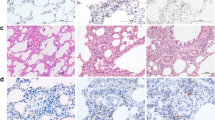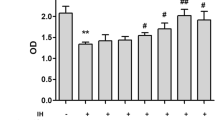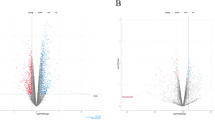Abstract
Purpose
Obstructive sleep apnea (OSA) is associated with lung injury. As a novel pathophysiological hallmark of OSA, chronic intermittent hypoxia (CIH) enhances apoptosis. The present study aims to evaluate the effect of resveratrol (Res) on CIH-induced lung apoptosis and inflammation in a rat model of CIH.
Methods
Rats were randomly allocated to normoxia (control), CIH, and CIH + Res groups (n = 10 in each group). The CIH exposure duration was 12 weeks. Rats in the CIH + Res group were additionally administered Res (50 mg kg–1 d–1). Inflammatory cytokine levels were detected by enzyme-linked immunosorbent assays (ELISAs). A terminal deoxynucleotidyl transferase dUTP nick-end labeling (TUNEL) assay was conducted to evaluate the apoptosis rate. Bax, cleaved caspase-3, Nrf2 and HO-1 protein levels were detected by western blotting.
Results
The IL-6 and TNF-α levels in the serum and alveolar lavage fluid in the CIH group were markedly higher than those in the control group. The percentage of apoptotic cells in the CIH group was higher than that in the control group. Bax and cleaved caspase-3 protein levels were increased in the CIH group compared with those in the control group. Nrf2 and HO-1 protein levels were decreased in the CIH group compared with those in the control group (p < 0.05). Compared with the CIH group, rats in the CIH + Res group had lower percentages of apoptotic cells, lower IL-6, TNF-α, Bax and cleaved caspase-3 protein levels, and higher Nrf2 and HO-1 protein levels (p < 0.05).
Conclusion
Res attenuates CIH-related inflammatory reactions and apoptosis in lung tissue by activating the Nrf2/ARE pathway.





Similar content being viewed by others
References
Jordan AS, McSharry DG, Malhotra A (2014) Adult obstructive sleep apnoea. Lancet 383(9918):736–747. https://doi.org/10.1016/S0140-6736(13)60734-5
de Lima FF, Mazzotti DR, Tufik S, Bittencourt L (2016) The role inflammatory response genes in obstructive sleep apnea syndrome: a review. Sleep Breath 20(1):331–338
Ren H, Hu K (2017) Inflammatory and oxidative stressassociated factors in chronic intermittent hypoxia in Chinese patients, rats, lymphocytes and endotheliocytes. Mol Med Rep 16(6):8092–8102. https://doi.org/10.3892/mmr.2017.7632
Li CG, Ni CL, Yang M, Tang YZ, Li Z, Zhu YJ, Jiang ZH, Sun B, Li CJ (2018) Honokiol protects pancreatic beta cell against high glucose and intermittent hypoxia-induced injury by activating Nrf2/ARE pathway in vitro and in vivo. Biomed Pharmacother. 97:1229–1237. https://doi.org/10.1016/j.biopha.2017.11.063
Zhang X, Rui L, Wang M, Lian H, Cai L (2018) Sinomenine attenuates chronic intermittent hypoxia-induced lung injury by inhibiting inflammation and oxidative stress. Med Sci Monit. 24:1574–1580. https://doi.org/10.12659/msm.906577
Lu W, Kang J, Hu K, Tang S, Zhou X, Yu S, Li Y, Xu L (2016) Angiotensin-(1–7) inhibits inflammation and oxidative stress to relieve lung injury induced by chronic intermittent hypoxia in rats. Braz J Med Biol Res. 49(10):e5431. https://doi.org/10.1590/1414-431X20165431
Yang QC, Sun X, Wang YM, Wu Q, Feng J, Chen BY (2015) Systematic and endothelial inflammation and endothelial progenitor cell levels in emphysematous rats exposed to intermittent hypoxia. Respir Care. 60(2):279–289. https://doi.org/10.4187/respcare.03492
Haslip M, Dostanic I, Huang Y, Zhang Y, Russell KS, Jurczak MJ, Mannam P, Giordano F, Erzurum SC, Lee PJ (2015) Endothelial uncoupling protein 2 regulates mitophagy and pulmonary hypertension during intermittent hypoxia. Arterioscler Thromb Vasc Biol. 35(5):1166–1178. https://doi.org/10.1161/ATVBAHA.114.304865
Liu KX, Chen GP, Lin PL, Huang JC, Lin X, Qi JC, Lin QC (2018) Detection and analysis of apoptosis- and autophagy-related miRNAs of mouse vascular endothelial cells in chronic intermittent hypoxia model. Life Sci. 193:194–199. https://doi.org/10.1016/j.lfs.2017.11.001
Song S, Tan J, Miao Y, Sun Z, Zhang Q (2018) Intermittent-hypoxia-induced autophagy activation through the ER-stress-related PERK/eIF2alpha/ATF4 pathway is a protective response to pancreatic beta-cell apoptosis. Cell Physiol Biochem. 51(6):2955–2971. https://doi.org/10.1159/000496047
Abdel-Wahab BA, Abdel-Wahab MM (2016) Protective effect of resveratrol against chronic intermittent hypoxia-induced spatial memory deficits, hippocampal oxidative DNA damage and increased p47Phox NADPH oxidase expression in young rats. Behav Brain Res 305:65–75. https://doi.org/10.1016/j.bbr.2016.02.030
Carreras A, Zhang SX, Almendros I, Wang Y, Peris E, Qiao Z, Gozal D (2015) Resveratrol attenuates intermittent hypoxia-induced macrophage migration to visceral white adipose tissue and insulin resistance in male mice. Endocrinology 156(2):437–443. https://doi.org/10.1210/en.2014-1706
Kostopanagiotou G, Avgerinos E, Costopanagiotou C, Arkadopoulos N, Andreadou I, Diamantopoulou K, Lekka M, Smyrniotis V, Nakos G (2008) Acute lung injury in a rat model of intestinal ischemia-reperfusion: The potential time depended role of phospholipases A (2). J Surg Res 147:108–116. https://doi.org/10.1016/j.jss.2007.07.023
McNicholas WT (2017) COPD-OSA overlap syndrome: Evolving evidence regarding epidemiology, clinical consequences, and management. Chest 152(6):1318–1326. https://doi.org/10.1016/j.chest.2017.04.160
Tudorache V, Traila D, Marc M, Oancea C, Manolescu D, Tudorache E, Timar B, Albai A, Fira-Mladinescu O (2019) Impact of moderate to severe obstructive sleep apnea on the cognition in idiopathic pulmonary fibrosis. PLoS ONE 14(2):e0211455. https://doi.org/10.1371/journal.pone.0211455
May AM, Van Wagoner DR, Mehra R (2017) OSA and cardiac arrhythmogenesis: mechanistic insights. Chest 151(1):225–241. https://doi.org/10.1016/j.chest.2016.09.014
Christou K, Moulas AN, Pastaka C, Gourgoulianis KI (2003) Antioxidant capacity in obstructive sleep apnea patients. Sleep Med 4(3):225–228
Zychowski KE, Sanchez B, Pedrosa RP, Lorenzi-Filho G, Drager LF, Polotsky VY, Campen MJ (2016) Serum from obstructive sleep apnea patients induces inflammatory responses in coronary artery endothelial cells. Atherosclerosis. 254:59–66. https://doi.org/10.1016/j.atherosclerosis.2016.09.017
Zhao D, Yin CY, Ye XW, Wan ZF, Zhao DG, Zhang XY (2019) Mitochondrial separation protein inhibitor inhibits cell apoptosis in rat lungs during intermittent hypoxia. Exp Ther Med. 17(3):2349–2358. https://doi.org/10.3892/etm.2019.7201
Wei Y, Jia J, Jin X, Tong W, Tian H (2018) Resveratrol ameliorates inflammatory damage and protects against osteoarthritis in a rat model of osteoarthritis. Mol Med Rep. 17(1):1493–1498. https://doi.org/10.3892/mmr.2017.8036
Aparicio-Soto M, Sanchez-Hidalgo M, Cardeno A, Rosillo MA, Sanchez-Fidalgo S, Utrilla J, Martin-Lacave I, Alarcon-de-la-Lastra C (2016) Dietary extra virgin olive oil attenuates kidney injury in pristine–induced SLE model via activation of HO-1/Nrf-2 antioxidant pathway and suppression of JAK/STAT, NF-kappaB and MAPK activation. J Nutr Biochem. 27:278–288. https://doi.org/10.1016/j.jnutbio.2015.09.017
Cheng L, Jin Z, Zhao R, Ren K, Deng C, Yu S (2015) Resveratrol attenuates inflammation and oxidative stress induced by myocardial ischemia-reperfusion injury: role of Nrf2/ARE pathway. Int J Clin Exp Med. 8(7):10420–10428
Acknowledgments
This work was supported by the National Natural Science Foundation of China (No. 81870074) and the Medical Elite Cultivation Program of Fujian in China (No. 2017-ZQN-43).
Author information
Authors and Affiliations
Contributions
Conception and design: NL, SZ, and QL. Collection and assembly of data: NL, SZ, and JH. Data analysis and interpretation: NL and SZ. Manuscript writing: all authors. Manuscript revision: NL and SZ. Final approval of the manuscript: all authors.
Corresponding author
Ethics declarations
Conflict of interest
The authors declare that they have no conflict of interest.
Ethical Approval
All procedures performed in studies involving animals were approved by the appropriate ethics committee and were performed in accordance with the ethical standards of the 1964 Declaration of Helsinki and its later amendments.
Additional information
Publisher's Note
Springer Nature remains neutral with regard to jurisdictional claims in published maps and institutional affiliations.
Rights and permissions
About this article
Cite this article
Lian, N., Zhang, S., Huang, J. et al. Resveratrol Attenuates Intermittent Hypoxia-Induced Lung Injury by Activating the Nrf2/ARE Pathway. Lung 198, 323–331 (2020). https://doi.org/10.1007/s00408-020-00321-w
Received:
Accepted:
Published:
Issue Date:
DOI: https://doi.org/10.1007/s00408-020-00321-w




